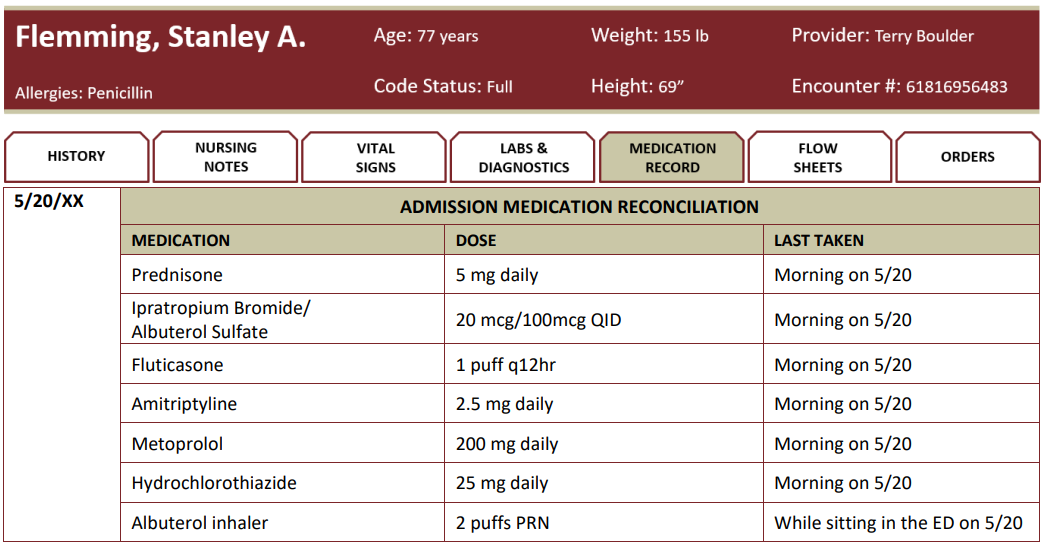4.1.1: FRAME 1- Recognize Cues
- Page ID
- 90007
\( \newcommand{\vecs}[1]{\overset { \scriptstyle \rightharpoonup} {\mathbf{#1}} } \)
\( \newcommand{\vecd}[1]{\overset{-\!-\!\rightharpoonup}{\vphantom{a}\smash {#1}}} \)
\( \newcommand{\id}{\mathrm{id}}\) \( \newcommand{\Span}{\mathrm{span}}\)
( \newcommand{\kernel}{\mathrm{null}\,}\) \( \newcommand{\range}{\mathrm{range}\,}\)
\( \newcommand{\RealPart}{\mathrm{Re}}\) \( \newcommand{\ImaginaryPart}{\mathrm{Im}}\)
\( \newcommand{\Argument}{\mathrm{Arg}}\) \( \newcommand{\norm}[1]{\| #1 \|}\)
\( \newcommand{\inner}[2]{\langle #1, #2 \rangle}\)
\( \newcommand{\Span}{\mathrm{span}}\)
\( \newcommand{\id}{\mathrm{id}}\)
\( \newcommand{\Span}{\mathrm{span}}\)
\( \newcommand{\kernel}{\mathrm{null}\,}\)
\( \newcommand{\range}{\mathrm{range}\,}\)
\( \newcommand{\RealPart}{\mathrm{Re}}\)
\( \newcommand{\ImaginaryPart}{\mathrm{Im}}\)
\( \newcommand{\Argument}{\mathrm{Arg}}\)
\( \newcommand{\norm}[1]{\| #1 \|}\)
\( \newcommand{\inner}[2]{\langle #1, #2 \rangle}\)
\( \newcommand{\Span}{\mathrm{span}}\) \( \newcommand{\AA}{\unicode[.8,0]{x212B}}\)
\( \newcommand{\vectorA}[1]{\vec{#1}} % arrow\)
\( \newcommand{\vectorAt}[1]{\vec{\text{#1}}} % arrow\)
\( \newcommand{\vectorB}[1]{\overset { \scriptstyle \rightharpoonup} {\mathbf{#1}} } \)
\( \newcommand{\vectorC}[1]{\textbf{#1}} \)
\( \newcommand{\vectorD}[1]{\overrightarrow{#1}} \)
\( \newcommand{\vectorDt}[1]{\overrightarrow{\text{#1}}} \)
\( \newcommand{\vectE}[1]{\overset{-\!-\!\rightharpoonup}{\vphantom{a}\smash{\mathbf {#1}}}} \)
\( \newcommand{\vecs}[1]{\overset { \scriptstyle \rightharpoonup} {\mathbf{#1}} } \)
\( \newcommand{\vecd}[1]{\overset{-\!-\!\rightharpoonup}{\vphantom{a}\smash {#1}}} \)
The medical-surgical nurse has been notified they are receiving an admission from the emergency department (ED). The nurse received a verbal report via telephone from the ED nurse and prepared the room for the client per unit procedures. The client arrives at the unit at 1430 and is accompanied by his wife of 32 years, Jean. The admitting nurse has charted the following information.



QUESTION: Multiple Response Select All That Apply Scoring Rule: +/-
What findings from Stanley’s admission to the medical-surgical floor are of immediate concern to the admitting nurse?
❑ T 101.9°F
❑ SpO2 86% on 3 L NC.
❑ Cachectic and poor appetite
❑ Hypoactive bowel sounds
❑ Course crackles bilateral lung fields
❑ Productive cough
❑ Accessory muscles while breathing
❑ Digital clubbing
❑ Smoking 15 cigarettes a day
❑ Respiratory rate 23 breaths/minute
Putting It All Together
DEBRIEF
The client’s oxygenation is compromised due to the COPD exacerbation. This is evident by the low pulse oximetry reading, tachypnea, utilization of the accessory muscles, and coarse crackles in the lung fields, making these priority concerns for the nurse. Additionally, the client’s fever and productive cough are of concern and could be indicative of an infectious process. The client’s poor appetite, cachectic appearance, digital clubbing, and smoking are not of immediate concern to the nurse. While these findings are important to the client’s holistic health picture, the nurse will want to act on the immediate compromised findings to improve the client’s immediate status.
COPD is a lung condition characterized by chronic respiratory symptoms from abnormalities in the airways and/or alveoli. This causes persistent and often progressive airflow and breathing problems. COPD is a major cause of chronic morbidity and mortality in the United States and worldwide. COPD is now one of the top three causes of death worldwide, and 90% of these deaths occur in low- and middle-income countries (Global Initiative for Chronic Obstructive Lung Disease, 2023). The lungs rely on their natural elasticity to bring air in and out of the body. COPD causes the lungs to lose their natural elasticity and remain in a hyperinflated state at exhalation. Limited airflow in clients with COPD is progressive and associated with environmental inflammatory responses. In conjunction with the inflammatory response, there is an increase in goblet cells leading to hypersecretion of mucus that can also impede oxygenation (Mayo Clinic, 2020).
RECOGNIZING SOCIAL DETERMINANTS OF HEALTH (SDOH)
This case study focuses on an individual with recurrent COPD exacerbations and addresses three of the five social determinants of health: Health Care Access & Quality, Neighborhood & Built Environment, and Social & Community Context. Each of these domains has a significant impact on individuals affected by COPD.
The domain, Neighborhood & Built Environment, includes related objectives specific to respiratory diseases such as COPD and asthma in both adults and children (RD-D04, RD-D03, RD-D01). Reducing the number of hospitalizations for these respiratory diseases, along with reducing environmental triggers and ensuring people get the right medications, is the focus of Healthy People 2030. Improving the health and safety in neighborhoods where people live will have a major impact on their health and well-being. Stanley’s reoccurring COPD exacerbations should not be overlooked from his home or neighborhood environment to help identify possible environmental triggers and other safety risks.
What Do You Think About?
- What is the effect of chronic inflammation on the pulmonary vasculature over time?
- Describe the multifaceted pathophysiology of COPD.
- What specific SDOH are impacting Stanley’s current health state?


